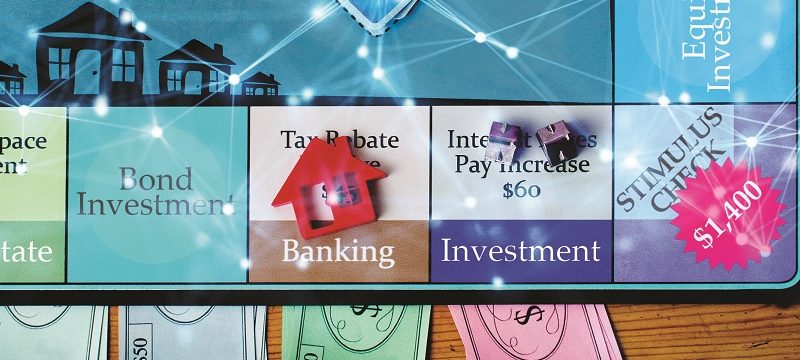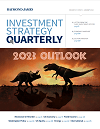by Larry Adam, CIO, Raymond James
Raymond James Chief Investment Officer Larry Adam examines the current investing environment through the lens of classic games.
Americans, bored in their COVID-induced bubbles, turned to board games for fun last year, boosting sales 300%. They rolled the dice, drew the cards, and buffed the skills of cooperation, problem solving, emotional intelligence, and reflective logic – the same competencies critical to successful investment strategies. So, we couldn’t help looking back nostalgically to our favorite games – and probably yours – as we look forward to crafting a sustainable investment game plan.
Like players in Clue®, “The Classic Mystery Game,” we have to be good detectives, hunting for clues to either affirm or alter our views. These unprecedented times are a whole new game, often demanding a fresh financial toolkit to solve the mysteries of the market. In other words, it’s no Trivial Pursuit®.
Remember how good you felt, passing Go in Monopoly® and collecting $200? Now imagine the U.S. economy as consumers pass Go with a collective $2 trillion in excess spending capacity as a result of Congress’ generous, stimulus-driven Community Chest. That chest continues to grow with the Child Tax Credit beginning in July and prospects for additional government infrastructure packages. While taxes are likely to move higher for corporations and the wealthy, the Income Tax card will be less onerous than originally outlined. With the U.S. debt ceiling likely raised by the end of July or soon thereafter, there is little Chance of government default or bankruptcy.
Of course, the real game-changer for the economy wasn’t the Get Out of Jail Free card; it was the “Get Out of the House for Free” vaccine process that has inoculated more than 60% (and growing) of U.S. adults. Now that consumers can join friends for dinner, go to sporting events and concerts, and travel on planes, the U.S. has regained all of its economic activity lost during the recession. The hot real estate market proves that people are buying properties in classic Monopoly® fashion and higher home prices are a key driver of the positive wealth effect for consumers. Once more, economic growth should go racing around the board on the back of robust consumer spending, rebuilding inventory levels, recovering foreign economies, and rising U.S. employment (expect an average of 500,000 new jobs a month over the next six months). As a result, 2021 GDP growth will likely meet, if not exceed, our expectation of 6.2% and remain strong into 2022.
In the 1960s, Milton Bradley introduced battery-powered Operation®, which tested kids’ ability to remove butterflies in the stomach and other ailments without setting off a buzzer. As the economy heals, the money doctors at the Federal Reserve (Fed) will be delicately removing some of the ultra-accommodative monetary policy that nursed the economy back to full speed. The trick: remove pieces from the accommodative policy without being zapped by surging inflation or short-circuiting the economy. The Fed will need to keep a steady hand and be patient. If inflation proves transitory and peaks during the third quarter as we expect, the Fed will be able to taper its bond purchases by late this year/ early next year and not raise rates until 2023.
Fixed income investors will need to remain flexible – like the players in the famous party game Twister®. Global investors will be stretching for yields in an environment of near record-low (if not negative) yields. Positive yields in the U.S. seem like a winner, continuing to attract foreign investors and keeping yields lower than valuations may suggest. However, the healthy U.S. economic environment and the uptick in inflation should push yields higher. These entangling forces are keeping yields knotted in a tight range, but we ultimately expect the 10-year Treasury to move modestly higher and finish the year at about 2.0%. If yields move decisively above 2%, don’t be surprised if the Fed adds its own Twist – purchasing bonds on the long end of the curve to keep interest rates lower. While the strength and breadth of the economy remain solid, valuations continue to favor the highest quality bonds from a risk/return perspective.
In equities, it’s easy to Connect Four® reasons why this young bull market will continue for the foreseeable future: 1) a still-improving macroeconomic backdrop; 2) attractive valuations, especially versus bonds; 3) increased shareholder activities in the form of growing dividends and buybacks; and 4) strong earnings growth expectations. With earnings growth expected to surge more than 60% during the second quarter and maintain a vigorous trend into 2022, equities should grind higher, albeit at a slower pace than over the last year. We revised our 2021 year-end target for the S&P 500 to 4,400 and expect it to rise to 4,600 by year-end 2022. A modest corporate tax increase to 25% (from the current 21%) shouldn’t deter a string of positive quarterly earnings. While our bias remains more U.S.-centric with a focus on U.S. large-cap and small-cap stocks, it’s possible an acceleration in reopenings in other parts of the world (like Europe) could lead to potential short- term trading opportunities. Our growth versus value positioning is more of a draw as our preference for big-cap Technology and Consumer Discretionary is offset by our preference for Financials, Energy, and Industrials.
So far this year it’s been Candy Land® for commodity investors, with gradual, sustainable reopenings across the globe leaving sellers vying for key inputs to satisfy pent-up demand. Investors found King Kandy as lumber and industrial metals raced to or near record highs due to bottlenecks. These price increases should subside as supply constraints dissipate. In terms of global oil demand, the recovery in North America, China, and Europe has been substantially realized, but still-intact COVID restrictions leave much of South Asia, with its 1.4 billion people, on the dreaded licorice space – the sticky spot that slows down the game. We anticipate it won’t be all lollipops and rainbows for global oil demand until mid-2022. Demand from South Asia is critical to reaching the pre-pandemic peak of 100 million barrels per day. OPEC+ (includes Russia) continues to exercise discipline in adjusting supply levels, but investors should consider the potential for U.S. sanctions to be lifted on Iranian oil. Therefore, we are only slightly raising our year- end target for West Texas Intermediate to $75 from $70 per barrel. Further supporting commodities is our expectation that the U.S. dollar will weaken slightly by year end versus major currencies like the euro (year-end target: 1.25 EURO/$).
Despite our optimistic message, there is no lack of potential Risk®: COVID variants, geopolitical tensions, and politics. However, taking on undue risk to your portfolio is Taboo®. Just like these classic games, the rules for investing remain timeless – adhere to your asset allocation strategy, periodically review your goals and objectives, don’t let emotion dictate your investment decisions, and, of course, work with your advisor. A successful investing team can make the real Game of Life® even more enjoyable.
Read the full
Investment Strategy Quarterly
Investment Strategy Quarterly is intended to communicate current economic and capital market information along with the informed perspectives of our investment professionals. You may contact your financial advisor to discuss the content of this publication in the context of your own unique circumstances. Published 7/1/2021.
Copyright © Raymond James















